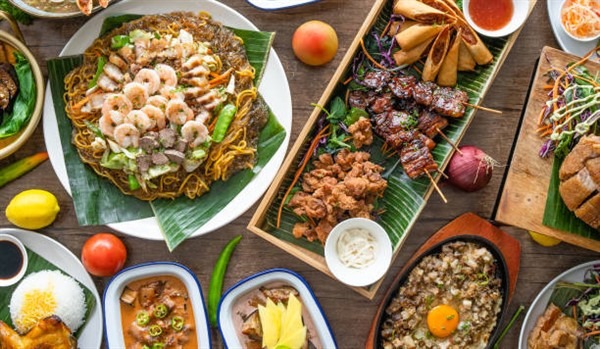Introduction
Food is a universal language that transcends borders and connects people from all walks of life. It has the power to evoke emotions, spark conversations, and create lasting memories. When we travel, one of the most exciting aspects is exploring the local cuisine and immersing ourselves in the food culture of a new place.
To truly appreciate the culinary world, it’s essential to understand the terminology and language associated with food in different parts of the globe. In this blog post, we’ll embark on a linguistic and gastronomic journey to learn how to say “food” in 100 different languages.
This knowledge will not only enrich your travel experiences but also deepen your appreciation for the diverse cultures that make up our global culinary tapestry.
Benefits of Learning How to Say “Food”
Before we delve into the linguistic adventure, let’s explore why it’s valuable to know how to say “food” in various languages:
Facilitating Cultural Immersion: Learning food-related vocabulary allows you to immerse yourself in the culture of the places you visit. It demonstrates respect for local customs and helps you connect with people on a deeper level.
Enhancing Travel Experiences: When you can communicate about food in the local language, you gain access to hidden gems, local markets, and authentic dining experiences that may not be readily available to tourists.
Building Connections with Locals: Speaking the language of food can break down barriers and lead to meaningful interactions with locals. It’s a fantastic conversation starter and a way to connect with people who share a passion for good food.
Fostering Culinary Exploration: Knowing how to say “food” opens doors to trying new dishes, exploring unique ingredients, and embarking on culinary adventures that you might have otherwise missed.
Essential Vocabulary: How to Say “Food” in Various Languages
Now, let’s explore the word “food” in 100 different languages. Here’s a curated list with phonetic pronunciations to help you get started:
- Afrikaans: Kos (kaws)
- Albanian: Ushqim (oosh-cheem)
- Amharic: ምግብ (migib)
- Arabic: طعام (taa’am)
- Armenian: աղջիկ (aġchik)
- Azerbaijani: Yemək (yem-ek)
- Basque: Janari (ha-nar-i)
- Belarusian: Ежа (ye-zha)
- Bengali: খাবার (khaw-bar)
- Bosnian: Hrana (khra-na)
- Bulgarian: Храна (khra-na)
- Burmese: အစ (ahc)
- Catalan: Menjar (muhn-zhar)
- Cebuano: Pagkaon (pahg-ka-on)
- Chichewa: Chakudya (chah-koo-ja)
- Chinese (Simplified): 食物 (shí wù)
- Chinese (Traditional): 食物 (shí wù)
- Croatian: Hrana (hrana)
- Czech: Jídlo (yeed-lo)
- Danish: Mad (mad)
- Dutch: Voedsel (food-sel)
- Esperanto: Manĝaĵo (mahn-jah-jo)
- Estonian: Toit (toit)
- Filipino: Pagkain (pahg-ka-een)
- Finnish: Ruoka (roo-oh-kah)
- French: Nourriture (noo-ree-toor)
- Frisian: Iten (ee-ten)
- Galician: Comida (co-mee-da)
- Georgian: კვება (kve-ba)
- German: Essen (eh-sen)
- Greek: Φαγητό (fa-gee-toh)
- Gujarati: ખોરાક (khoh-rak)
- Haitian Creole: Manje (mahn-zhay)
- Hausa: Abinci (ah-been-chee)
- Hebrew: אוכל (o-khel)
- Hindi: खाना (khah-na)
- Hmong: Ntsuab (nts-wah)
- Hungarian: Étel (ay-tel)
- Icelandic: Matur (ma-tur)
- Igbo: Ji (jee)
- Indonesian: Makanan (ma-ka-nan)
- Irish: Bia (bee-uh)
- Italian: Cibo (chee-bo)
- Japanese: 食品 (shoku-hin)
- Javanese: Panganan (pahng-ah-nahn)
- Kannada: ಆಹಾರ (aahaara)
- Kazakh: Тамақ (ta-maq)
- Khmer: អាហារ (ah-ka)
- Kinyarwanda: Ibikwiye (ee-bee-kwee-yay)
- Korean: 음식 (eum-shik)
- Kurdish (Kurmanji): Xwarin (khwa-rin)
- Kyrgyz: Тамак (ta-mak)
- Lao: ອາຫານ (ah-han)
- Latin: Cibus (kee-boos)
- Latvian: Ēdiens (yed-yens)
- Lithuanian: Maistas (mai-stas)
- Luxembourgish: Iessen (ee-ess-en)
- Macedonian: Храна (khra-na)
- Malagasy: Laoka (la-oo-ka)
- Malay: Makanan (ma-ka-nan)
- Malayalam: ഭക്ഷണം (bhaksha-nam)
- Maltese: Ikla (ik-la)
- Maori: Kai (kah-ee)
- Marathi: अन्न (ann)
- Mongolian: Хоол (khool)
- Myanmar (Burmese): အစာ (ah-sa)
- Nepali: खाना (khah-na)
- Norwegian: Mat (maht)
- Pashto: خوراک (khwa-rahk)
- Persian (Farsi): غذا (ghaza)
- Polish: Jedzenie (ye-dzen-yeh)
- Portuguese: Comida (ko-mee-da)
- Punjabi: ਖਾਣਾ (kha-na)
- Romanian: Mâncare (muhn-ka-re)
- Russian: Еда (ye-da)
- Samoan: Mea’ai (may-a-eye)
- Scots Gaelic: Biadh (bee-ah)
- Serbian: Храна (khra-na)
- Sesotho: Lijo (lee-joh)
- Shona: Chakudya (chah-koo-ja)
- Sindhi: کان (kaan)
- Sinhala: ආහාර (ahara)
- Slovak: Jedlo (yed-lo)
- Slovenian: Hrana (khra-na)
- Somali: Cunto (choon-toh)
- Spanish: Comida (co-mee-da)
- Sundanese: Gudangan (goo-dang-an)
- Swahili: Chakula (cha-koo-la)
- Swedish: Mat (maht)
- Tajik: Охури (okhuri)
- Tamil: உணவு (oo-nah-voo)
- Telugu: ఆహారం (aahaaram)
- Thai: อาหาร (ah-han)
- Turkish: Yiyecek (yee-yeh-jek)
- Ukrainian: Їжа (yizha)
- Urdu: کھانا (khana)
- Uzbek: Oziq-ovqat (o-zeek o-vqat)
- Vietnamese: Thực phẩm (twek fahm)
- Welsh: Bwyd (booid)
- Yiddish: עסן (essen)
Learning how to say “food” in these languages is a fantastic starting point for your culinary journey around the world. It’s a simple but powerful way to show respect for the cultures you encounter.
Practical Applications
Now that you have this vocabulary at your fingertips, let’s explore how you can use it in practical situations:
- Ordering at Restaurants and Markets: When dining out or shopping for ingredients, using the local term for “food” can help you communicate your preferences and navigate menus and markets more effectively.
- Grocery Shopping in Foreign Countries: While travelling, you may need to buy groceries. Knowing how to ask for “food” in the local language can make this task more manageable.
- Navigating Food Allergies and Preferences: If you have dietary restrictions or allergies, being able to communicate your needs in the local language is crucial for a safe and enjoyable dining experience.
- Engaging in Food-Related Conversations: Whether you’re chatting with locals about their favourite dishes or discussing culinary traditions, knowing how to say “food” is the key to meaningful conversations.
Challenges and Tips
Learning new languages can be challenging, but it’s also incredibly rewarding. Here are some tips to help you on your linguistic journey:
Pronunciation Difficulties: Pronouncing words correctly is vital for effective communication. Practice regularly, listen to native speakers, and don’t be afraid to ask for feedback.
Regional Dialects and Variations: Keep in mind that languages can have regional dialects and variations. The word for “food” may differ slightly from one region to another.
Expanding Your Culinary Vocabulary: Once you’ve mastered “food,” consider learning other food-related terms, such as ingredients, dishes, and cooking methods.
Resources and Tools for Language Learning: Take advantage of language learning apps, online courses, and language exchange programs to enhance your language skills.
The Joy of Culinary Exploration
Learning how to say “food” in different languages not only aids in communication but also opens doors to culinary exploration. It encourages you to try new dishes, savour local specialities, and gain a deeper understanding of the culture through its cuisine.
As you travel, remember that food is not just sustenance; it’s a window into the heart and soul of a place and its people. So, go ahead, embrace the adventure, and savour the world one “food” at a time!
Conclusion
In a world where diversity is celebrated and borders are crossed with ease, the ability to communicate across cultures is a valuable skill. Learning how to say “food” in 100 different languages is a small yet meaningful step towards cultural appreciation and understanding. It’s an invitation to explore the world, one meal at a time, and to connect with people through a shared love for food.
So, as you embark on your travels or simply explore the international cuisine available in your own city, don’t forget to add “food” to your linguistic repertoire. It’s a passport to unforgettable culinary experiences and the beginning of a lifelong journey of cultural exploration.













